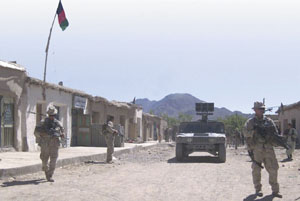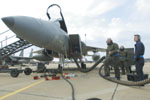Information Operations Specialists Move to Mission Planners' Table
 |
| Members of the 22nd Marine Expeditionary Unit escort a speaker-equipped U.S. Army psychological operations high-mobility multipurpose wheeled vehicle through the streets of Khas Oruzgan, Afghanistan, during operation Pegasus. One of the operation’s goals was to disrupt and deter enemy activity in the region. |
Although centuries old, information operations is fast becoming the newest strategic weapon in the
Leading this metamorphosis for the joint community is the Joint Information Operations Center (JIOC), Lackland Air Force Base,
To accomplish this task, the JIOC works with joint commanders to incorporate information operations capabilities into mission plans. The center’s approximately 370 personnel, who include members from all the services as well as civilians, contractors and reservists, principally work with the unified combatant commands (COCOMs). The members of its nine COCOM support teams—one team for each of the commands—meet regularly with COCOM staff members to support both exercises and real-world planning and operations. Collaboration takes the form of either face-to-face interaction—team members are stationed at the commands—or as a reach-back resource when videoconferencing capabilities are available. The core COCOM support teams, which comprise an average of 14 individuals each, may be augmented with JIOC intelligence, planning and command, control, communications and computers (C4) experts. JIOC personnel also provide information operations expertise to the Office of the Secretary of Defense, the Joint Staff and the services.
In its work with the COCOMs, the support teams help the combatant commanders with the information operations portion of their existing plans. In addition to assisting them in updating and revising their overall strategies, JIOC personnel particularly focus on how they can facilitate information operations integration into the COCOMs’ planning process, Col. Rayfield relates.
Along with ongoing support, the JIOC assists combatant commanders with crisis action planning for real-world operations. For example, immediately after the terrorist attacks of September 11, 2001, the center’s U.S. Central Command (CENTCOM) support team as well as intelligence, planning and C4 experts drove to
JIOC personnel offer options to joint commanders about which elements of information operations can or should be used and the effects they are likely to generate. “One of the important things about information operations is that, just like any other type of military planning, it needs to be in there from the beginning and that’s what we try to do. After the plans are already built, it’s hard to get information operations integrated,” he states.
In recent years, military commanders have come to realize the power of information operations, and Col. Rayfield says this is one of the most significant improvements he has witnessed. An increase in awareness, education and training as well as progress in doctrine and policy development has made commanders more cognizant of what information operations are and what they can do, he maintains. Although the tendency has been to associate information operations only with computer network operations, commanders now understand that other aspects of information operations can be just as powerful, he says.
“More commanders are starting to realize what a military capability information operations are if they’re integrated early, often and continuously throughout planning and operations. They realize what a force multiplier they can be. With money, time and capabilities, you can influence someone not to do something or to do something that you want them to do without having to send our service members in harm’s way. That’s a plus,” he says.
A number of initiatives are advancing this improved understanding. The U.S. Defense Department’s information operations road map, which Col. Rayfield predicts will be complete within a year, is one step toward highlighting the effect information operations can have on military missions. Several of the working groups that are developing the road map are focusing on specific elements of information operations, such as electronic warfare and operations security.
Additionally, the Defense Department supports the move toward an educated and ready information operations career force, and courses have been designed to train military personnel in joint information operations. In terms of continuing education, the
A number of other changes have occurred that affect information operations. Advances in information technology have improved information warfare tools and created new ones. The JIOC itself has been using information technology to further its work. For example, the Information Operations Navigator, which the colonel affectionately calls “TurboTax for information operations,” is an information operations planning tool.
 |
| Avionics specialists from the 94th Air Maintenance Unit inspect the electronic warfare capability of a U.S. Air Force F-15 Eagle during an operation readiness exercise. Electronic warfare is now considered one element of information operations. |
Although information technology supports
The widespread use of communications technologies in information operations has had a broader effect, he adds. Computer systems protection has improved, and awareness has grown in the
As in other warfighting areas, the need to work with other nations has influenced the information operations realm. Improvements that began with
“It’s very important that not just the JIOC but the U.S. continues to develop these relationships because not only are we not going to go it alone, our allies and some of our coalition partners have some great capabilities that, if we work better together, we can capitalize on. In some instances, they may have more cultural awareness of a particular area where we have problems because it’s in their backyard,” Col. Rayfield says.
And the cultural characteristics of a region can influence how information operations are carried out, particularly when trying to shape an adversary’s behavior, the colonel states. The JIOC is trying to increase military leaders’ awareness of the cultural aspect of psychological operations. By examining differences and similarities, commanders can determine how to focus the message and therefore better affect behavior, he says.
Lessons learned from current operations reiterate not only the importance of integrating information operations into planning but also the value of keeping information operations in mind while missions are underway, Col. Rayfield states. “Information operations actions need to be coordinated and integrated so that we can avoid information operations fratricide. For example, if we are putting out a psychological operations message over AM radios, it’s going to be ineffective if, on the electronic warfare side, we’re also jamming AM radio frequencies,” he points out.
Work in the aftermath of hurricanes Katrina and Rita also brought to light some unconventional uses for information operations, the colonel relates. For instance, psychological operations units often stock items such as loudspeakers and broadcast systems as well as printing equipment to mass-produce leaflets. Military and government personnel can use these resources to quickly and simultaneously disseminate pertinent information such as shelter and aid station locations to crowds of evacuees.
Because information operations are multifaceted by nature, developing the tools and techniques to conduct them requires assistance in many different areas, and Col. Rayfield says the commercial sector can assist in several ways. Helping to develop technology tools that facilitate the collaborative planning process is one way industry can assist the JIOC; however, the center also can benefit from working with industry in nontraditional ways. “Terrorists are not using traditional military processes. They’re using existing commercial, financial, transportation and communications processes or systems to do their evil business. Industry can assist us in those areas also,” he notes. For example, industry develops marketing strategies to influence the buying habits of customers with different cultural backgrounds. These techniques could have applications in information operations.
Col. Rayfield says the JIOC has several initiatives in the works that will help information operations continue to evolve. The center is working toward expanding its electronic warfare and operations security capabilities and is increasing its involvement with strategic communications.
In addition, the JIOC is moving forward with its Joint Multidiscipline Vulnerability Assessment initiative. The effort will involve a systematic and comprehensive review of the operations security posture of organizations and commands. Among the items that would be examined during the review are whether an organization has an operations security program and trained personnel in place as well as the status of a critical information list and standard security operating procedures.
Web Resources




Comments